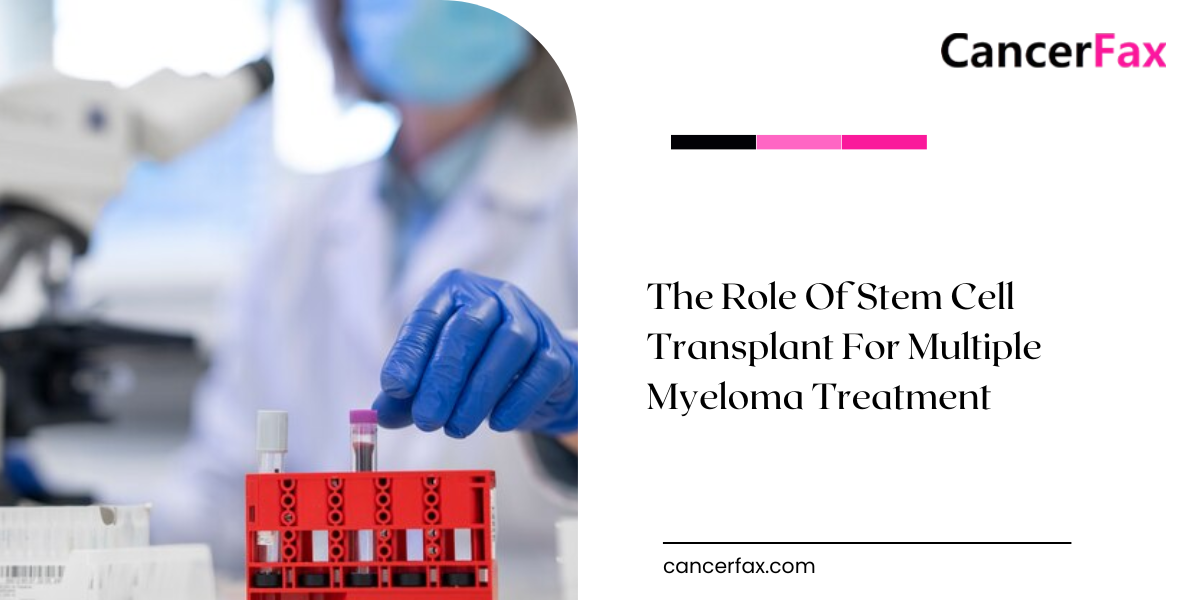How Stem Cell Transplant Is Reshaping The Future Of Multiple Myeloma Treatment?
Stem cell transplantation is an effective treatment for multiple myeloma, a type of blood cancer. This procedure has shown promising results in improving the lives of those with multiple myeloma, offering a new chance for healing. Join us on a journey of possibilities and positive change in myeloma care – it’s a must-read for anyone seeking a new perspective on cancer treatment!
Multiple myeloma is a kind of cancer that affects plasma cells, which are an important element of the immune system located in the bone marrow. When these plasma cells become cancerous, they can multiply uncontrollably, squeezing out healthy blood cells.
This can result in weakening bones, anemia, kidney issues, and a weakened immune system.
Effective treatments are crucial to win this challenging game of survival. They’re the ones that bring hope, restore health, and make the fight against multiple myeloma less daunting.
When it comes to treating multiple myeloma, one of the best multiple myeloma treatment in India is the stem cell transplant. In this blog, we will discuss the Stem Cell Transplant for Multiple Myeloma and its transformative impact on individuals battling this blood cancer.
Join us on this enlightening journey as we explore the twists and turns equipped with knowledge, hope, and the drive to make a difference in the lives of cancer patients.

What Are Some Other Multiple Myeloma Treatments Available In India?
Other than stem cell transplant, your doctor can also ask you to undergo the following treatment, depending upon your condition:
Chemotherapy:
Chemotherapy for multiple myeloma involves the use of powerful drugs that target and prevent the rapid growth of cancer cells, affecting their ability to divide and spread.
Immunotherapy:
CAR T cell therapy treatment in India is an innovative immunotherapy treating all types of blood cancers. This personalized approach involves modifying a patient’s own T cells to target and destroy cancer cells.
Moreover, the cost of car t cell therapy in India is much more affordable compared to other countries.
Radiation Therapy:
Radiation therapy uses high doses of focused radiation to destroy or damage myeloma cells in specific places. While it’s effective for symptom relief and reducing tumor size, its use is often limited to specific situations due to the possibility of side effects.
What Role Do Stem Cells Perform In Our Body?
Stem cells are a very special type of cell made early in our bone marrow. These stem cells mature and form red blood cells, white blood cells, and platelets. Stem cells are essential for growth, tissue repair, and maintaining overall health.
In the early stages of life, embryonic stem cells can evolve into any cell type, laying the foundation for the body’s complex structure.
Throughout life, adult stem cells reside in various tissues, ready to replace damaged or aging cells, contributing to the body’s continuous renewal and regeneration. This unique capability of stem cells holds tremendous promise for treating complex diseases like blood cancer.
What Is Stem Cell Transplant For Multiple Myeloma?
A stem cell implant is an effective therapy option for persons suffering from multiple myeloma. This treatment includes replacing harmful blood cells with healthy ones in order to boost the chances of overcoming the disease.
While a stem cell transplant is not a cure, studies show that it improves survival rates when compared to chemotherapy alone.
In the fight against multiple myeloma, high-dose cancer treatment is often required. However, a strong treatment can harm bone marrow, the spongy tissue inside bones that produces blood cells.
The transplant effectively reboots the marrow, enabling it to generate healthy blood cells once again. While stem cell therapy for multiple myeloma in India has proven to be helpful for many people, it is important to note that it may not be appropriate for everyone.
So, it’s better to consult your doctor and learn about the options you have before starting the stem cell transplant procedure.
Stages of Multiple Myeloma Disease
The disease progresses through various stages, and these stages are typically classified using the International Staging System (ISS) or the Revised International Staging System (R-ISS). The higher the stage number, the more myeloma is in the body.
Multiple Myeloma 1st stage
When the disease is in Stage I, the serum beta-2 microglobulin level is lower (less than 3.5 mg/L), the albumin level is higher (3.5 g/dL or higher), and there are no high-risk cytogenetic abnormalities.
Multiple Myeloma 2nd stage
Cases in Stage II do not match the requirements for either Stage I or Stage III. It is a transitional stage with varied clinical characteristics and prognosis.
Multiple Myeloma 3rd stage
Stage III is marked by more advanced disease, featuring higher serum beta-2 microglobulin levels, lower albumin levels, and the presence of high-risk cytogenetics.
What Are The Types Of Stem Cell Transplants?
Based on the source of the stem cells, there are five basic types of stem cell treatments, and each type can be further classified based on the donor. The following are the primary types:
Autologous Stem Cell Transplant
In an autologous stem cell transplant for multiple myeloma, the patient serves as their own stem cell donor. Around half of people dealing with multiple myeloma can go for this kind of transplant, and it’s considered the best way to combat the disease.
Allogeneic Stem Cell Transplant
In an allogeneic transplant, stem cells are obtained from a donor, who could be a close family member or an unrelated donor. Your brother or sister is often the best fit, but if they’re not available, there’s a chance to find an unrelated donor who matches well.
The drawback is that this stem cell transplant for multiple myeloma is more risky than using your own cells. However, they can be more powerful in fighting cancer because the donor’s cells can attack any sneaky myeloma cells that survived the earlier treatment.
Syngeneic Stem Cell Transplant
This is a type of allogeneic transplant in which the donor and recipient are identical twins. If you’re fortunate enough to have an identical twin, this could be your golden ticket.
Because you and your twin have an identical genetic composition, the transplanted cells are the best possible match. This process for stem cell transplantation is a remarkable advantage in the fight against multiple myeloma, making the treatment journey smoother and more effective.
Tandem Stem Cell Transplant
This procedure for stem cell transplant for multiple myeloma consists of two dynamic autologous transplants: first, you receive a strong round of cancer treatment; then, to promote healing, your own healthy stem cells are infused.
After a few months, you repeat the entire process with an additional round of therapy and an additional autologous transplant.
Studies suggest that, for some individuals, this stem cell transplant process might be more effective than just one transplant. However, there could be more side effects compared to a single autologous transplant.
Mini Stem Cell Transplant
A mini stem cell transplant is like a gentler approach in the fight against multiple myeloma, especially if you’re a bit older or dealing with other health issues.
This type of stem cell transplant procedure for multiple myeloma is allogeneic, meaning you receive donor cells, but it relies more on these donor cells to destroy the cancer cells.
The biggest benefit is that you will receive lower initial doses of chemo and radiation, making the whole process gentler.
Know The Stem Cell Transplant Process For Multiple Myeloma
The stem cell procedure for multiple myeloma is a meticulously planned series of steps designed to replace damaged or cancerous cells with healthy stem cells.
Phase of Preparation:
Your medical team examines your overall health, disease stage, and the availability of a suitable donor (if allogeneic).
Depending on the type of transplant, you may undergo high-dose chemotherapy, radiation, or a combination to eliminate cancer cells and make a place for the donated cells.
Collection of Stem Cells:
Previously, these cells were extracted directly from the bone marrow in a technique known as a bone marrow harvest, which sounds pretty intense. But guess what? Nowadays, it’s much simpler.
Most of the time, these superhero cells are collected from the bloodstream. Whether you are the donor or someone else is, you will be given a particular medicine to stimulate the growth of these cells and encourage them to leave the marrow.
The blood is then passed through a tube in a large vein to a machine that collects the stem cells and returns the remainder of the blood to your body.
These collected cells are frozen until they’re needed, waiting patiently for their turn to join the fight against multiple myeloma when you’re ready for them.
Transplantation:
Following conditioning therapy, the collected stem cells (either your own or from a donor) are infused into your bloodstream, similar to a blood transfusion. The collected stem cells will enter your bone marrow and make new blood cells.
Phase Of Recovery
The stem cell recovery period after a transplant is like a journey back to full health after a tough battle. If you underwent an allogeneic transplant, doctors monitor how well your new cells integrate with your body.
Graft-versus-host disease occurs when donor cells begin fighting your body. But don’t panic, doctors can typically treat it. Now, how long does it take to recover?
It will take 2-6 weeks for your blood counts to return to normal. After a few weeks, when your counts are high enough to fight infections and prevent bleeding, you may be allowed to go home.
However, the recovery process does not finish there; it can take six months or longer to fully recover. Even when you’re at home, your doctors will keep a careful eye on you to ensure everything is in order.
Know The Side Effects Of A Stem Cell Transplant
While a stem cell transplant is a powerful and potentially life-saving surgery, it can have a number of negative effects which are as follows –
Fatigue
Diarrhea or constipation
Low blood cell counts
Sore mouth
Loss of appetite
Weight loss
Hair loss
Reduced concentration
What Is The Life Expectancy After Stem Cell Transplant For Multiple Myeloma?
After stem cell transplant for multiple myeloma life expectancy is promising. If you make it through the first 2 to 5 years post-transplant, the chances of living for another 10 years go up to around 80 percent.
This means that if you manage your symptoms well, keep your immune system in good shape, and take care of yourself, there’s a good chance of having a long and healthy life.
What Is The Cost Of Stem Cell Transplant For Multiple Myeloma In India?
The cost of stem cell treatment procedure in India ranges between Rs. 8 Lakhs to Rs. 40 Lakhs.
How CancerFax Can Help You?
In wrapping up the role of stem cell transplants for multiple myeloma treatment, it’s like having a powerful weapon in the fight against this challenging disease.
The process is difficult, with ups and downs, but completing it often implies a better chance of living a longer, healthier life. We can help you find the best hospitals and meet the right specialists in India.
We have been providing exceptional patient care since 2019 at an affordable cost. Get in touch for increased chances of well-being and survival.
Dr. Nishant Mittal is a highly accomplished researcher with over 13 years of experience in the fields of cardiovascular biology and cancer research. His career is marked by significant contributions to stem cell biology, developmental biology, and innovative research techniques.
Research Highlights
Dr. Mittal's research has focused on several key areas:
1) Cardiovascular Development and Regeneration: He studied coronary vessel development and regeneration using zebrafish models1.
2) Cancer Biology: At Dartmouth College, he developed zebrafish models for studying tumor heterogeneity and clonal evolution in pancreatic cancer.
3) Developmental Biology: His doctoral work at Keio University involved identifying and characterizing medaka fish mutants with cardiovascular defects.
4) Stem Cell Research: He investigated the effects of folic acid on mouse embryonic stem cells and worked on cryopreservation techniques for hematopoietic stem cells.
Publications and Presentations
Dr. Mittal has authored several peer-reviewed publications in reputable journals such as Scientific Reports, Cardiovascular Research, and Disease Models & Mechanisms1. He has also presented his research at numerous international conferences, including the Stanford-Weill Cornell Cardiovascular Research Symposium and the Weinstein Cardiovascular Development Conference.
In summary, Dr. Nishant Mittal is a dedicated and accomplished researcher with a strong track record in cardiovascular and cancer biology, demonstrating expertise in various model systems and a commitment to advancing scientific knowledge through innovative research approaches.
- Comments Closed
- December 20th, 2023






allogeneic transplant risks, ASCT procedure steps, autologous transplant for myeloma, multiple myeloma bone marrow transplant, myeloma relapse post-transplant, stem cell harvest process, stem cell transplant myeloma, transplant recovery timeline
CancerFax is the most trusted online platform dedicated to connecting individuals facing advanced-stage cancer with groundbreaking cell therapies.
Send your medical reports and get a free analysis.
🌟 Join us in the fight against cancer! 🌟
Привет,
CancerFax — это самая надежная онлайн-платформа, призванная предоставить людям, столкнувшимся с раком на поздних стадиях, доступ к революционным клеточным методам лечения.
Отправьте свои медицинские заключения и получите бесплатный анализ.
🌟 Присоединяйтесь к нам в борьбе с раком! 🌟